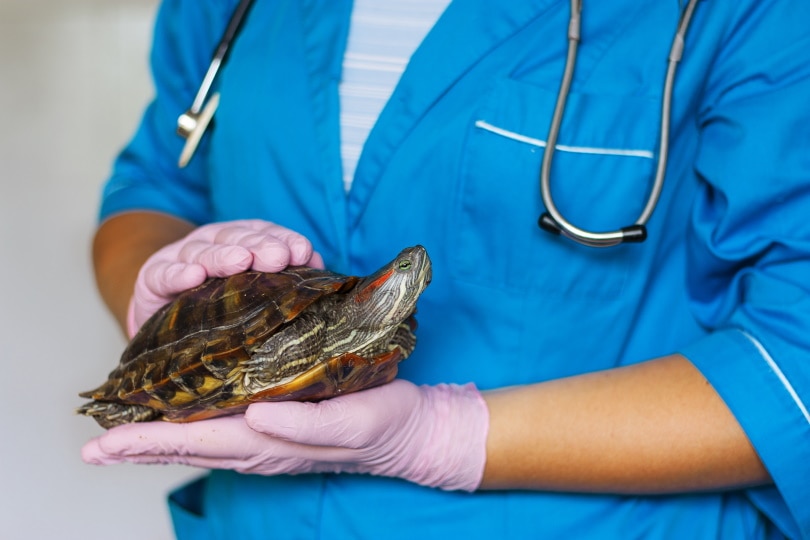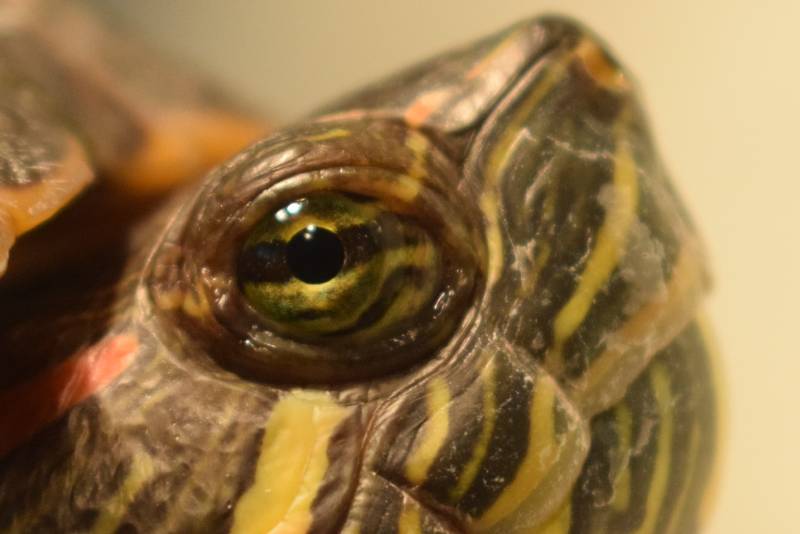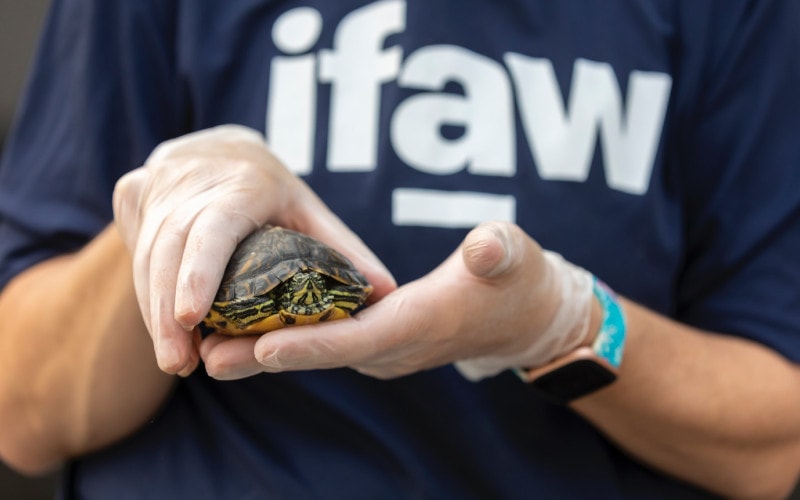
One of the most common health issues for a turtle is eye disease. This includes eye infections, which can cause permanent damage to the eye or even cause the turtle to lose the eye entirely and are usually caused by an underlying problem with the turtle or its environment.
You’ll need to know about the types of eye infections a turtle can get and what to do about them if you’re planning to keep or work with them.
Signs of an Eye Infection in Turtles

Despite the many different species of turtles, some living in salt water, fresh water, land, or some combination thereof, their eye infections all look similar and come from similar causes.
A turtle with an eye injection may have a cloudy eye, eye discharge, swollen eyelids, an eye that sticks out or is shrunken, blood in or around the eye, visible “dents” or scratches on the surface of the eye, nasal discharge, oral lesions, drooling, lethargy, inappetence, and more.
Many eye infections have underlying causes that may or may not be related to the eye, so signs of these infections can vary greatly.
The 4 Most Common Turtle Eye Infections
1. Bacterial
This is the most common type of eye infection a turtle might get, and a wide number of species cause these. The reason for this is that most bacterial eye infections in turtles are caused by bacterial species they already have on their body, which normally don’t cause a problem. If the turtle becomes ill, immunosuppressed, or stressed, if there’s trauma to the eye, or if they’re exposed to an active infection from another turtle, then that bacterial infection can become a problem.
Examples of bacterial species that can cause an eye infection in turtles include the following:
Bacterial eye infections in turtles are treated with topical or possibly oral antibiotics depending on the species responsible. Swabs of a turtle’s conjunctiva or eye discharge can allow a veterinarian to culture the bacteria and determine not only what species are present but also which antibiotics are most effective for treatment.
It’s not uncommon for bacterial infections to also be present in the mouth or nasal passage, so treatment may be needed for more than just their eyes.
2. Fungal

Fungal eye infections are turtles’ second most common type of eye infection. These occur for mostly the same reasons as bacterial infections; they rely heavily on the turtle already being ill or stressed with possibly poor water quality around them for aquatic turtles.
Fungal species that can cause eye infections in turtles include Candida spp., Aspergillus spp., and Curvularia spp.
Something that can sometimes identify a fungal eye infection rather than a bacterial one is how commonly it eats away at the eye rather than causing swelling and discharge. These are dangerous eye infections that can take much longer to treat, so you want to avoid these in your turtle at all costs.
Fungal eye infections are treated with—you guessed it—antifungals. These are usually oral medications though topical preparations such as Miconazole drops can be found too. A veterinarian needs to diagnose the fungal eye infection first and then prescribe medication, so make sure a turtle with an eye infection is seen as soon as you notice signs.
3. Viral
Viral eye infections are almost always due to the spread of a viral infection from somewhere else in the body.
The most common culprit is herpesvirus, but viral eye infections could also be caused by ranavirus, or rarely and only documented in the wild, fraservirus.
These viral infections are often upper respiratory infections that spread to the eyes and can include significant nasal discharge, oral discharge or lesions, breathing trouble, lethargy, and other systemic (throughout the body) signs.
Viral infections can be tricky to treat. Antiviral medications like L-lysine or acyclovir are available and can help with signs of illness, but treating underlying problems that weaken and predispose them to infection is also important.
When a turtle has herpesvirus, which is incredibly common across turtle species, they have the virus for life, but it spends most of its time “latent”, meaning it isn’t causing illness. In times of stress or illness, the herpes virus can flare up and cause signs again until the virus and any secondary bacterial infections are treated, and then the turtle can appear normal again. This is why it’s so important to treat the underlying cause of illness in viral eye infections in turtles.
4. Abscesses

Abscesses are a particular version of the above infections. Instead of the eye globe itself being infected, encapsulated areas of infection can develop instead, usually behind the eye or in the eyelid.
These abscesses can trigger similar signs, such as an eye that protrudes or has a discharge, and they can also seed an infection in the eye itself, so the two can be related.
Abscesses in turtles are best treated by lancing them and giving the turtle antibiotics. This is because turtles and other reptiles lack the enzyme to break down infectious and white blood cell debris inside an abscess that would then be resorbed. The contents for a turtle’s abscess are also usually thicker than in mammals, a cottage cheese-type consistency described as “caseous”.
Alternative Eye Diseases of Turtles
There are other different but often related eye diseases of turtles you should know about, too. The presence of any of these diseases can trigger eye infections in addition to having ocular signs themselves. Treating these other issues is sometimes an important part of treating an eye infection.
Some of these other diseases and conditions would be hypovitaminosis A (vitamin A deficiency), tumors, trauma, conjunctivitis, upper respiratory tract infections, corneal ulcers, or cataracts.
Vitamin A deficiency is often an assumed component of any turtle eye infection that includes conjunctivitis or swelling and is a default part of treatment most of the time.

Frequently Asked Questions (FAQs)
Are all turtles at risk for eye problems?
Yes, they are. In most cases, this is because of poor water quality for aquatic turtles, and/or vitamin A deficiency for others. Since these eye problems can cause infections in other parts of the body, lead to blindness, and may be caused by an infectious agent that is also dangerous to people, it is important to have a veterinarian examine the turtle and treat the eye problem rather than attempt to treat from home.
Can I use human eye drops on my turtle?
While there is a large overlap between eye drops used in turtles and those available for people, not all human eye drops are safe for turtles nor do they treat every type of eye infection or problem, so human eye drops should only be used in turtles, even those available over the counter, under the supervision of a veterinarian.

Can Neosporin be used on turtles?
While this may be okay for a skin lesion, it is never okay to apply to a turtle’s eye and should only be used at all when recommended by a veterinarian.
Conclusion
Turtle eye problems are very common, and the cause just might be an infection. Since there are so many different types of infections, it’s important to have a veterinarian assess what’s happening and why to get the best results from treatment. The first signs of an issue may be swelling or discharge from the eye, but sometimes a turtle will be ill in a different part of the body first, which spreads to the eyes.
Treating a turtle eye infection can be tricky but a treatment plan can be designed based on the size and temperament of each turtle. If you have more than one turtle living together, be sure to quarantine any turtle that shows signs of an eye infection as soon as you notice them, then make an appointment to be evaluated by a vet.
- You might also be interested in: Common Diseases in Aquatic Turtles: Signs, Causes & Treatments
Featured Image Credit: ALIAKSANDR PALCHEUSKI, Shutterstock








